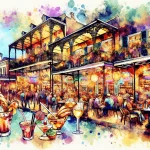New Orleans’ French Market, located in the vibrant French Quarter, has been a cornerstone of the city’s culinary scene for over 200 years. This historic open-air market showcases the best of the Big Easy’s cuisine, offering a variety of local delicacies and unique flavors. From classic dishes like gumbo and jambalaya to sweet treats like pralines and beignets, the French Market is a food lover’s paradise that highlights New Orleans’ rich food culture.
In This Article
TL;DR
- The French Market plays a crucial role in preserving and promoting New Orleans‘ culinary heritage, serving as a hub for local chefs, farmers, and food artisans.
- Visitors can find an array of unique food items at the French Market, such as alligator sausage, crawfish pies, and muffulettas, deeply rooted in the city’s cultural identity.
- The market’s food offerings reflect the diverse influences that have shaped New Orleans’ cuisine over the centuries, including African, French, Spanish, and Italian traditions.
Historical Context of the French Market
The French Market traces its origins back to 1791, when it was established as a trading post along the Mississippi River. Over the years, the market has undergone numerous transformations, surviving hurricanes, fires, and renovations. Despite these changes, the French Market has remained a constant presence in the city’s food culture, serving as a gathering place for locals and visitors alike.
During the late 19th century, the market became a hub for Sicilian immigrants, who introduced new ingredients and dishes to the city’s culinary landscape. This period saw the rise of iconic foods like the muffuletta sandwich, which was created by Central Grocery to cater to the Sicilian dockworkers who frequented the market.
Signature Dishes and Ingredients at the French Market
The French Market is renowned for its variety of signature dishes that showcase the best of New Orleans’ cuisine. Some must-try items include:
- Gumbo: A hearty stew made with a dark roux, vegetables, and meat or seafood, served over rice.
- Jambalaya: A rice dish featuring meat, vegetables, and Creole seasonings.
- Po’boys: A submarine sandwich on French bread, typically filled with fried seafood or roast beef.
- Muffulettas: A sandwich made with round sesame bread, layered with olive salad, genoa salami, ham, mortadella, provolone, and Swiss cheese.
Many of these dishes incorporate locally sourced ingredients, such as Gulf seafood, Andouille sausage, and fresh produce from nearby farms. Chefs at the French Market often put their own spin on traditional recipes, creating modern twists that keep the city’s culinary traditions alive and evolving.
Culinary Techniques and Food Preparation
The French Market is known for its characteristic cooking methods that enhance the flavor and presentation of its food. Some notable techniques include:
- Slow-cooking: Many dishes, such as gumbo and red beans and rice, are simmered for hours to allow the flavors to meld and intensify.
- Grilling: Seafood, such as oysters and shrimp, is often grilled over an open flame to impart a smoky flavor.
- Deep-frying: Fried foods, like beignets and fried catfish, are a staple at the French Market, with vendors using high-quality oils to ensure a crispy texture.
The market is home to a variety of chefs, from seasoned veterans to up-and-coming talents, who bring their own unique perspectives and techniques to the table. Many of these chefs have gained national recognition for their contributions to New Orleans’ food scene, helping to cement the French Market’s reputation as a culinary destination.
Daily Operations and Vendor Insights
The French Market is a bustling hub of activity, with vendors setting up their stalls early in the morning and serving customers until late in the evening. The market is divided into several sections, including the Farmers Market Pavilion, where visitors can find fresh produce and specialty food items, and the Flea Market, which features an eclectic mix of crafts, clothing, and souvenirs.
Some key vendors to visit include:
- Cafe Du Monde (800 Decatur St): Known for its iconic beignets and café au lait.
- Alberto’s Cheese & Wine Bistro (1100 N Peters St): Offers a selection of muffulettas, sandwiches, and salads.
- J’s Seafood Dock (1100 N Peters St): Serves fresh Gulf oysters, crawfish, and other seafood dishes.
Many vendors at the French Market prioritize sustainability, sourcing their ingredients from local farmers and fishermen whenever possible. This commitment to supporting the local economy and minimizing environmental impact helps to ensure the long-term viability of the market and its food offerings.
Seasonal and Festival Foods
The French Market’s offerings vary throughout the year, with vendors showcasing seasonal ingredients and special dishes during New Orleans’ many festivals. Some notable events include:
- Mardi Gras (February/March): During Carnival season, vendors offer traditional treats like king cake and Mardi Gras-themed snacks.
- French Quarter Festival (April): This free music festival features food booths from local restaurants, including many French Market vendors.
- Creole Tomato Festival (June): Celebrates the iconic Creole tomato with food demos, tastings, and tomato-centric dishes.
These festivals provide a unique opportunity for visitors to experience the French Market’s food culture in a festive atmosphere, with live music, parades, and other entertainment adding to the ambiance.
Visitor Experience and Practical Tips
To make the most of your visit to the French Market, consider the following tips:
- Come hungry: With so many delicious options to choose from, it’s best to arrive with an appetite and sample a variety of dishes.
- Talk to the vendors: Many of the market’s vendors are passionate about their food and are happy to share their knowledge and recommendations with curious visitors.
- Explore beyond the main building: While the French Market’s main building houses many popular food stalls, don’t miss the surrounding areas, such as the Farmers Market Pavilion and the Flea Market, for additional culinary delights.
Some must-visit stalls and hidden gems include:
- Meals From The Heart Cafe (1100 N Peters St): Offers vegan and gluten-free options, including smoothies and salads.
- Organic Banana (1100 N Peters St): Serves fresh fruit smoothies and juices, perfect for a healthy snack.
- Mother Nature’s Cupboard (1100 N Peters St): Features a selection of local honey, jams, and other specialty food items.
By taking the time to explore the French Market’s diverse offerings and engage with its vendors, visitors can gain a deeper appreciation for New Orleans’ rich culinary heritage and the role the market plays in preserving it.
Cultural and Economic Impact of the French Market
The French Market is more than just a food destination; it is a vital part of New Orleans’ cultural and economic landscape. The market provides a platform for local chefs, farmers, and artisans to showcase their products and skills, helping to support the city’s small businesses and entrepreneurial spirit.
Moreover, the French Market serves as a living museum of New Orleans’ culinary history, preserving traditional recipes and techniques that have been passed down through generations. By attracting visitors from around the world, the market helps to promote the city’s unique food culture and cement its status as a global culinary capital.
As the French Market continues to evolve and adapt to changing tastes and trends, it remains committed to its core mission of celebrating New Orleans’ culinary heritage and supporting the local community. With plans for future developments and collaborations with local chefs and food artisans, the market is poised to remain a vibrant and essential part of the city’s food scene for generations to come.






